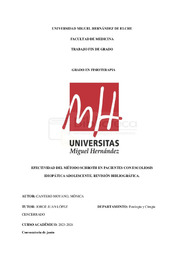Resumen :
Introducción: La escoliosis idiopática del adolescente (EIA) es la deformidad estructural más común de la columna vertebral en adolescentes. Es de etiología desconocida y más frecuente en mujeres que hombres. Se diagnostica cuando el ángulo de Cobb supera los 10º. Los principales problemas que provoca son disminución de la calidad de vida, dolor y limitación de la función pulmonar y del equilibrio. Los ejercicios fisioterapéuticos específicos para la escoliosis (PSSE) son uno de los métodos más utilizados para tratarla, siendo el método Schroth uno de los más conocidos en la actualidad.
Objetivos: Investigar mediante la literatura científica el efecto del método Schroth en adolescentes con escoliosis idiopática (EI).
Material y métodos: Se realizó una búsqueda bibliográfica en las bases de datos Pubmed, Scopus, PEDro y Web of Science desde 2014 hasta la actualidad; utilizando artículos que estudiaran el método Schroth como tratamiento para la EIA.
Resultados: Se revisaron 17 artículos; de ellos, 11 evaluaron el ángulo de Cobb con radiografía en la mayoría de casos, 11 midieron el ángulo de rotación del tronco (ATR) con escoliómetro y/o test de Adam y 10 evaluaron la calidad de vida gracias al cuestionario SRS-22 o SRS-23.
Conclusiones: El método Schroth ha demostrado ser efectivo para tratar la EIA reduciendo el ángulo de Cobb y ATR, mejorando la calidad de vida y función respiratorias de adolescentes con EI, entre otros beneficios. Además, la combinación del método Schroth con otras terapias, como la hipoterapia, demuestra resultados superiores.
Introduction: Adolescent idiopathic scoliosis (AIS) is the most common structural deformity of the spine, whose etiology is unknown and it is more common in females than males. It’s diagnosed when the Cobb angle exceeds 10°. The main problems it causes are decreased quality of life, pain and limitation of lung function and balance. Physiotherapeutic scoliosis-specific exercises for scoliosis (PSSE) are one of the most widely used methods of scoliosis treatment, the Schroth method being one of the best known today.
Objectives: To investigate the effect of the Schroth method in adolescents with idiopathic scoliosis (IS) based on the scientific literature.
Material and methods: A literature search was conducted on the Pubmed, Scopus, PEDro and Web of Science databases from 2014 to the present, as well articles addressing the Schroth method as AIS treatment.
Results: 17 articles were reviewed; from which, 11 assessed the Cobb angle with a radiography in most cases, 11 measured the angle of trunk rotation (ATR) with a scoliometer and/or the Adam's test and 10 assessed quality of life using the SRS-22 or SRS-23 questionnaire.
Conclusions: The Schroth method has been shown to be effective in treating AIS; reducing the Cobb angle and ATR, improving the quality of life and respiratory function of adolescents with IE, among other benefits. In addition, the combination of the Schroth method with other therapies, such as hippotherapy, shows superior results.
|
 La licencia se describe como: Atribución-NonComercial-NoDerivada 4.0 Internacional.
La licencia se describe como: Atribución-NonComercial-NoDerivada 4.0 Internacional.
.png)
